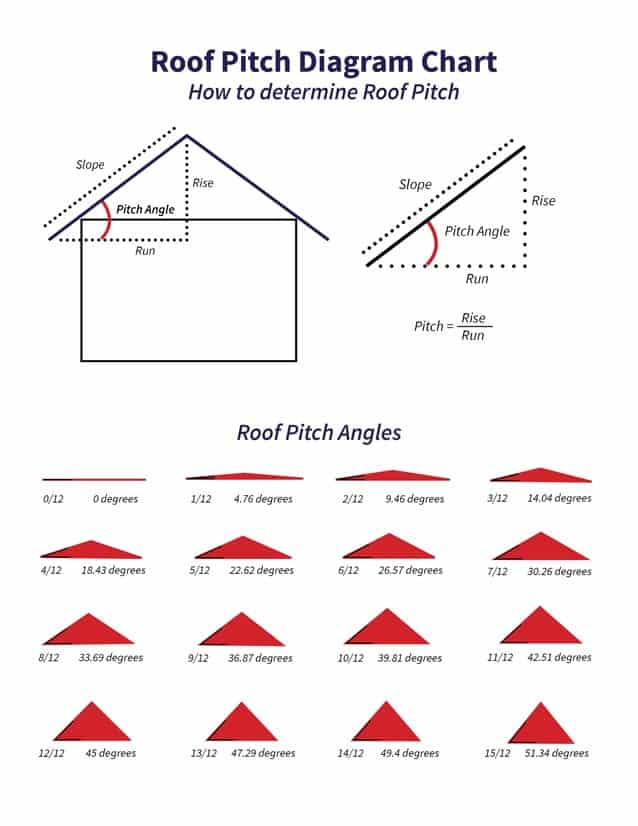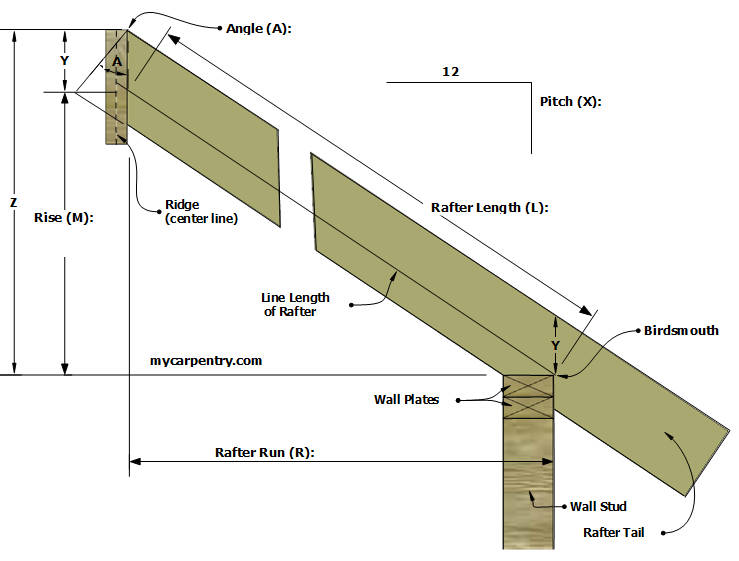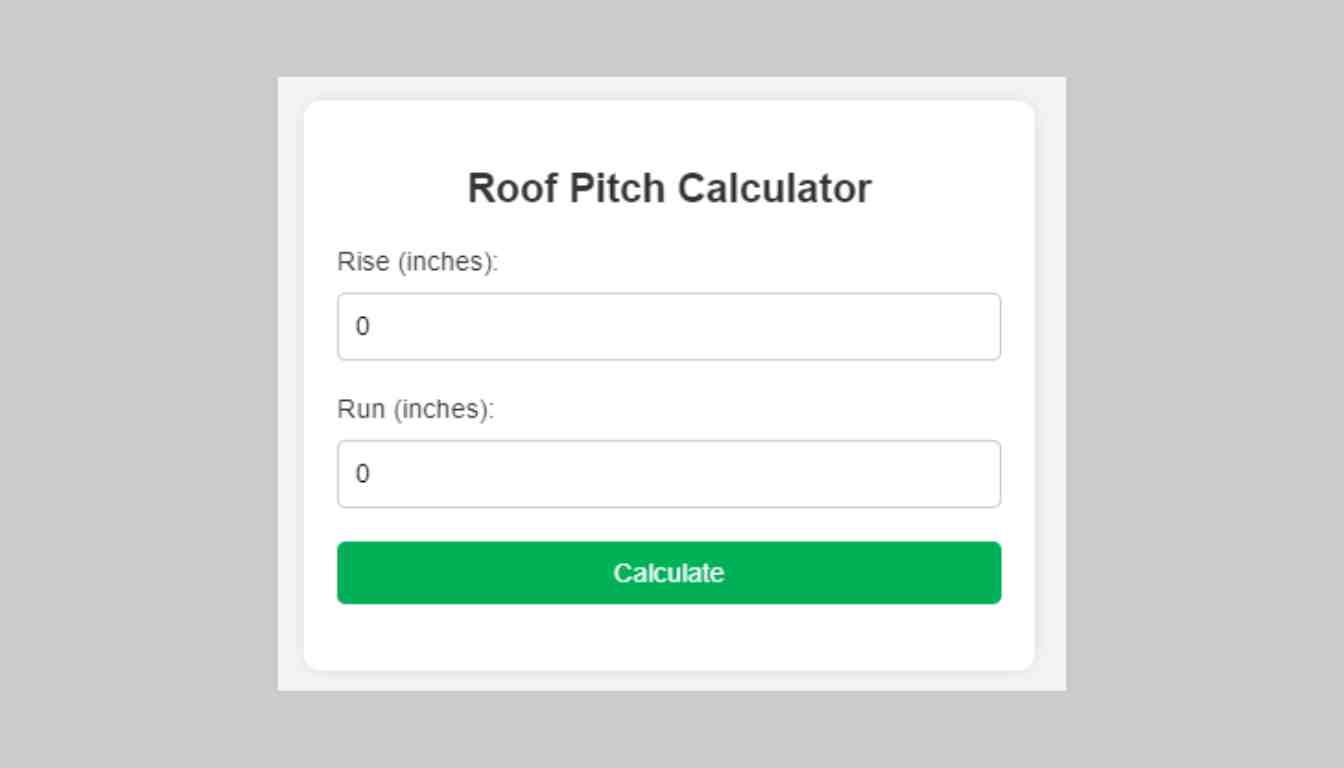A roof pitch calculator computes the angle and slope of a roof based on the rise and run. It aids in determining the appropriate roof pitch for construction and rainwater drainage.
Embarking on a roofing project requires precision, and a crucial aspect of this is understanding the pitch or incline of your roof. Our online roof pitch calculator is an invaluable tool that seamlessly translates roof dimensions into the pitch, expressed as an angle or a ratio.
This tool is indispensable for architects, builders, and DIY enthusiasts planning roofing installations or repairs. By inputting the basic measurements – the ‘rise’ (height of the roof) and the ‘run’ (horizontal span) – you can swiftly identify the necessary pitch for efficient water runoff and aesthetic harmony with the building’s design. Ensuring your calculations are accurate promotes safety, supports structure integrity, and adheres to local building codes, making the roof pitch calculator a key step in project planning.

Credit: www.pinterest.com
The Importance Of Accurate Roof Pitch Measurement
The Importance of Accurate Roof Pitch Measurement cannot be overstated. The roof pitch or slope determines how well a roof performs in terms of drainage and structural integrity. Accurate measurement is crucial for new installations, repairs, or replacements. Getting the angle right ensures the roof functions properly and lasts for years to come.
Ensuring Effective Water Runoff
Correctly measuring roof pitch is vital for effective water runoff. A roof too flat may hold water, leading to leaks and damage. Conversely, a steep roof needs special attention to handle runoff safely. Use a roof pitch calculator to ensure the slope promotes efficient drainage, preventing water accumulation.
- Avoids water pooling
- Prevents structural damage
- Reduces maintenance costs
Determining The Right Materials
Selecting the right materials depends on the measured roof pitch. Different materials work best at specific pitches. For example, asphalt shingles require a certain minimum slope. A roof pitch calculator aids in choosing materials suited for your roof’s design, ensuring durability and cost-effectiveness.
| Material | Minimum Pitch |
|---|---|
| Asphalt Shingles | 2:12 |
| Metal Panels | 3:12 |
| Rubber Membrane | 1/4:12 |
Use a precise roof pitch calculator for perfect material selection. This ensures your roof handles the elements and lasts years.
Anatomy Of A Roof
Before you grab a roof pitch calculator, let’s explore a roof’s anatomy. Roofs are not just layers of shingles or tiles. They have complex structures. Each part plays a role in keeping your home safe. Let’s dig into these parts and understand common roof designs.
Understanding Roof Structure
Do you know what makes up your roof? It’s more than what you see from the street. Here are the key parts:
- Trusses/rafters: These are the bones. They create the roof’s shape.
- Decking: This wooden layer sits on the trusses. It supports everything above.
- Underlayment: This water-resistant barrier protects the decking.
- Shingles or tiles: These are the outermost parts. They keep water out.
- Flashing: These metal pieces prevent water from entering joints.
- Soil stack: This pipe vents your home’s plumbing system.
Understanding these helps you use a roof pitch calculator effectively.
Common Roof Styles And Pitches
Roofs come in many styles. The pitch, or slope, affects design and function. Here are some popular types:
| Style | Pitch | Description |
|---|---|---|
| Gable | Moderate to steep | Has a classic triangle shape |
| Hip | Moderate | Slopes on all four sides |
| Flat | Almost level | Lacks pitch, not truly flat |
| Mansard | Steep lower slope | Features two slopes on each side |
| Gambrel | Varied | Looks like a barn, has two slopes |
Different pitches handle weather differently. Use a roof pitch calculator to match the right pitch to your style.
Measuring Roof Pitch: Traditional Methods
Determining the angle of your roof, known as the pitch, is critical for any roofing project. Traditional methods often provide a hands-on approach for accurate measurements. Let’s explore some tried-and-true techniques to gauge roof pitch.
Using A Carpenter’s Level
This straightforward technique involves only a few tools you might already have. You’ll need a 12-inch carpenter’s level and a tape measure. Here’s how to do it:
- Access the roof and lay the level flat against the shingles.
- Ensure the bubble is centered.
- Measure 12 inches from where the level meets the roof.
- From that point, measure vertically down to the roofing surface.
- This measurement is the rise of a 12-inch run. Note this as the pitch.
The Rafter Method
For greater precision, you might opt for the rafter method. This requires you to:
- Find the midpoint of a rafter from underneath the roof.
- Place a level at this midpoint, keeping it perfectly horizontal.
- From the 12-inch mark on the level, measure down to the rafter.
- Record the vertical distance. That’s the rise over a 12-inch run.
Both methods give you a reliable reading of the roof’s pitch. These traditional methods are essential for DIY enthusiasts or professionals before using a roof pitch calculator.
Digital Age Solutions: Roof Pitch Calculator
Calculating the pitch of a roof is crucial in construction and renovation. A digital roof pitch calculator simplifies this task. Builders and DIY enthusiasts find this tool invaluable. It provides precise measurements quickly and efficiently. Now, exploring the digital age solutions for roofing calculations is essential.
Benefits Of Using A Calculator
Accuracy and Time-Saving are the top benefits. Roof pitch calculators reduce human error. They offer exact pitch measurements in minutes. Users save hours that they’d otherwise spend on manual calculations.
- User-Friendly: Even novices use this technology with ease.
- Safe Measurements: No need to climb a roof for pitch data.
- Cost-Effective: Fewer errors mean less wasted materials.
Features To Look For In A Digital Calculator
Selecting the right calculator involves understanding key features.
| Feature | Description |
|---|---|
| Intuitive Interface | Allows users to input data easily and interpret results quickly. |
| Multifunctional Capabilities | Can calculate various roofing elements besides pitch. |
| Mobile Compatibility | Accessible via phone or tablet for on-the-go calculations. |
Compatibility with different roof styles is another vital feature. Whether it’s gable or hip roofs, the right calculator handles all. It should also include a helpful user guide and customer support for maximum utility.
Future-proof calculators offer regular updates. These adapt to changing industry norms and technologies. Your choice must support both imperial and metric systems, imperative for international projects.
Choosing the perfect roof pitch calculator sets the foundation for successful roofing projects. Opt for one with all these features to ensure quality and efficiency.
Step-by-step Guide To Using A Roof Pitch Calculator
Roof pitch matters when planning a new roof or renovation. A roof pitch calculator simplifies this step. It helps homeowners and professionals find the right angle for their roof. Follow this easy guide to use a roof pitch calculator. With accurate inputs, you get results that guide your project.
Inputting Basic Measurements
Get ready to input measurements into the roof pitch calculator. You need two main figures:
- Run: the horizontal distance from the roof’s peak to the wall.
- Rise: the vertical height from the peak down to the level of the eaves.
Tips for accuracy:
- Measure the run from the outer wall.
- Use a level to find the true vertical rise.
- Input numbers in feet or meters, as the calculator requires.
Precision is key. Small mistakes can affect the calculator’s outcomes.
Reading The Results
After entering your data, the calculator gives you the pitch. This number is a ratio. It shows how many inches the roof rises every 12 inches of run. Look for these results:
| Pitch Ratio | Rise Over Run | Type of Slope |
|---|---|---|
| 2/12 | Low Slope | 2 inches rise per 12 inches |
| 4/12 | Medium Slope | 4 inches rise per 12 inches |
| 9/12 | Steep Slope | 9 inches rise per 12 inches |
A calculator might offer extra details:
- Angle in Degrees: useful for contractors
- Roof Length: aids in estimating materials needed
Use this information wisely. It guides your choices of roofing materials and structures. Be sure to save or write down the calculations for future reference.

Credit: roofvents.com
Putting Pitch Calculations Into Practice
Roof pitch is a critical factor in construction and renovation projects. It impacts everything from the type of materials you choose to the feasibility of installing solar panels. With a reliable roof pitch calculator, you can confidently tackle these aspects with precision. Let’s explore how to apply these calculations effectively.
Choosing The Right Materials Based On Pitch
Your roof’s pitch determines the best materials for durability and weather resistance. Here’s a simple guide to help you match pitch with materials:
- Low-pitched roofs – Opt for materials like rolled roofing.
- Medium-pitched roofs – Choose asphalt shingles or metal roofing.
- Steep pitches – Consider tiles or slate for their gravity-defying properties.
Pitch Calculations For Solar Panel Installations
Solar panels need the right pitch to maximize sun exposure. Use the calculator to ensure your roof pitch aligns with these key points:
| Pitch Angle | Solar Panel Efficiency |
|---|---|
| 15-30 degrees | Ideal for most locations |
| 30-45 degrees | Optimal for higher latitudes |
| Above 45 degrees | Beneficial in snowy regions |
Check local sun charts and combine that data with your pitch calculations for the most efficient setup.
Troubleshooting Common Issues With Pitch Calculations
Figuring out the pitch of a roof is crucial for many construction and renovation projects. A Roof Pitch Calculator simplifies this task. Despite its usefulness, users sometimes stumble upon issues. Dive into common problems and their solutions in pitch calculations.
Dealing With Irregular Roof Shapes
Not all roofs follow simple geometric patterns. Irregular shapes pose a challenge. For these, an average pitch value might not reflect true architecture. To troubleshoot:
- Break the roof into manageable sections.
- Calculate the pitch for each part individually.
- Combine these calculations to understand the full complexity.
Adjusting For Measurement Errors
Precision is key when measuring a roof’s pitch. Small errors can lead to skewed results. Be on the lookout for:
- Tools that are not calibrated correctly.
- Misreading the measurements or inputting incorrect numbers.
- Wear and tear on measuring equipment.
Confirm all tools are accurate and functional. Take measurements multiple times to ensure consistency. Input data carefully to avoid typos that disrupt calculations.

Credit: www.mycarpentry.com
Beyond Pitch: Additional Uses For Roof Calculators
Roof calculators do more than just measure slope. They are vital tools for a range of tasks. Understanding roof pitch paves the way to accurate project planning. Yet, these robust calculators assist with cost estimation and ventilation strategy too.
Estimating Roofing Costs
Calculating the cost of a new roof can be daunting. Roof calculators make it simple. They help break down the overall expense into clear components. Let’s look at how they benefit the budget:
- Measure total roof area easily
- Determine material needs without guesswork
- Include local labor rates for precise calculations
Using a table, variables such as material costs and labor can be methodically organized. Here’s an example:
| Material | Cost per Square Foot | Total Area (sq ft) | Subtotal |
|---|---|---|---|
| Asphalt Shingles | $3.50 | 1500 | $5250 |
| Labor | $2.00 | 1500 | $3000 |
This method keeps your budget transparent and manageable.
Planning For Roof Ventilation
A well-ventilated roof is key to a home’s integrity. A roof calculator helps plan a balanced ventilation system. Here are the steps:
- Calculate attic square footage
- Use roof pitch data for vent placement
- Determine number of vents based on area
With bold clarity, the calculator outputs the data needed to ensure a home stays cool in summer and dry during winter.
Frequently Asked Questions On Roof Pitch Calculator
What Is A Roof Pitch Calculator?
A roof pitch calculator is a tool that determines the slope of a roof. It calculates the angle, pitch, and length of the roof based on input measurements. Such calculators help in planning and constructing roofs.
How Does Roof Pitch Impact Construction Costs?
Roof pitch affects construction costs as steeper slopes require more materials and labor. High-pitched roofs might increase costs due to the complexity of installation and the need for additional safety measures during the construction process.
Can I Calculate Roof Pitch From The Ground?
Yes, roof pitch can be estimated from the ground with the help of level and measuring tape, followed by some simple calculations. For accuracy, it’s often best to measure directly on the roof or use a roof pitch calculator app.
What Is The Standard Roof Pitch For Homes?
The standard roof pitch for homes typically ranges from 4/12 to 9/12. This means for every 12 inches horizontally, the roof rises 4 to 9 inches. However, the desired pitch may vary based on climate and architectural style.
Conclusion
Calculating your roof’s pitch doesn’t have to be daunting. A reliable roof pitch calculator simplifies the process, ensuring precision and saving time. Whether you’re planning construction or evaluating current structures, having accurate measurements is invaluable. For your next roofing project, embrace the ease of a digital calculator and get spot-on results every time.


